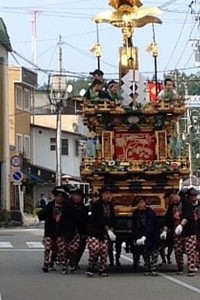 The Japanese also play hard, and some of the biggest, most labor-intensive parties take place in the street during traditional festivals. The fall festival in the city of Takayama, where our daughter teaches English, is one of the most spectacular.
The Japanese also play hard, and some of the biggest, most labor-intensive parties take place in the street during traditional festivals. The fall festival in the city of Takayama, where our daughter teaches English, is one of the most spectacular.
Takayama’s festival is famous for its yatai, some of which are 300 years old. Yatai are elaborately carved and richly decorated three story wooden wagons. People ride in the wagons, and many have small groups of children on board, playing traditional Japanese flutes and drums.
Unlike our floats, yatai are not mechanized. They don’t have steering wheels. Instead they are pulled through the streets by elaborately costumed teams. This is where the effort comes in, for yatai weigh several tons and they are not easy to steer or to turn.
The two-day fall festival in Takayama involves 11 yatai. On the opening morning, the yatai are parked on display near the festival’s home Shinto shrine. In the early afternoon, a small cohort are paraded through the street for several hours. Then in the evening, all 11, decorated from top to bottom with lighted lanterns, are pulled through the town.
To do so, the members of their teams have different jobs. Some march in front, pulling the yatai with thick ropes. Other crew members hover near the front of the wagon, serving as human brakes when needed. Still other team members march behind. At least one or two fellows use thick wooden posts to steer the wagon from the front and back and correct its course as it moves down the street.
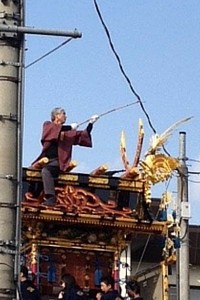
The yatai pause when they come to a corner. In order to make the sharp turn, the yatai must be tilted and oblique wheels lowered. Then the team grabs onto the float and, pushing altogether, rotates it 90 degrees. The spare wheels are retracted, and the float is set back on regular wheels. Then the arduous pulling, braking, and steering resumes.
Those who ride on the yatai can also have challenging jobs, for some wagons are so tall that they will not pass under the electric wires that hang over the street. We watched one grey-haired gentleman climb up on the third story roof with long stick to lift the wire so that the elaborate golden phoenixes adorning the roof did not catch on the wires.
Clearly, it requires a lot of effort to have fun in Japan!

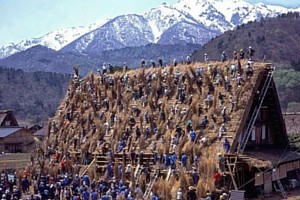 Working hard is a tradition in Japan. Nowhere is this clearer than in Shirakawa-go, a remote farming village located in the mountainous region of Honshu between Takayama and Kanazawa. Shirakawa-go, now a UNESCO World Heritage site, is an outstanding example of a traditional way of life perfectly adapted to the environment and the resident’s social and economic circumstances.
Working hard is a tradition in Japan. Nowhere is this clearer than in Shirakawa-go, a remote farming village located in the mountainous region of Honshu between Takayama and Kanazawa. Shirakawa-go, now a UNESCO World Heritage site, is an outstanding example of a traditional way of life perfectly adapted to the environment and the resident’s social and economic circumstances. I just spent three weeks traveling around Japan by train with my husband and daughter. Both of them can speak and read Japanese. I cannot. Consequently, I am useless when it comes to most verbal transactions.
I just spent three weeks traveling around Japan by train with my husband and daughter. Both of them can speak and read Japanese. I cannot. Consequently, I am useless when it comes to most verbal transactions.
 Effort is not only about doing; it is also about being, or what Rudolf Laban calls movement thinking. “Movement thinking could be considered as a gathering of impressions of happenings in one’s own mind, for which nomenclature is lacking. This thinking does not serve orientation in the external world but rather it perfects man’s orientation in his inner world.”
Effort is not only about doing; it is also about being, or what Rudolf Laban calls movement thinking. “Movement thinking could be considered as a gathering of impressions of happenings in one’s own mind, for which nomenclature is lacking. This thinking does not serve orientation in the external world but rather it perfects man’s orientation in his inner world.”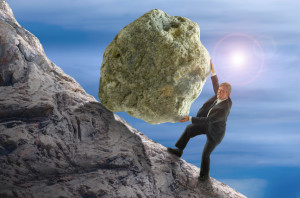 Every voluntary human movement involves applying energy to change the position of the body. Energy can be applied in many different ways. Rudolf Laban referred to these various qualities of kinetic energy as
Every voluntary human movement involves applying energy to change the position of the body. Energy can be applied in many different ways. Rudolf Laban referred to these various qualities of kinetic energy as 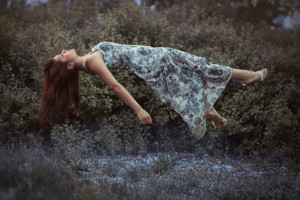
 In the previous two blogs I have been contrasting body language and body movement. Body language tends to isolate still poses and particular gestures from the stream of ongoing bodily action and read fixed meanings into these snapshots. In so doing, the process of change, which is the essence of movement, disappears, as does the broader context of sequential actions. Body language treatises tend to present a stilted and mechanistic view of movement behavior. Perhaps this is why much of the study of body language promises to improve an individual’s ability to manage his/her image and manipulate others.
In the previous two blogs I have been contrasting body language and body movement. Body language tends to isolate still poses and particular gestures from the stream of ongoing bodily action and read fixed meanings into these snapshots. In so doing, the process of change, which is the essence of movement, disappears, as does the broader context of sequential actions. Body language treatises tend to present a stilted and mechanistic view of movement behavior. Perhaps this is why much of the study of body language promises to improve an individual’s ability to manage his/her image and manipulate others. Henri Bergson, the French philosopher, was fascinated by how analytical thinking leads us to misperceive our own experience of being alive. For Bergson, life is an unceasing, continuous, undivided process, a sort of cosmic movement. Yet, we tend to conceive our lives as passing from feeling to feeling or thought to thought, as if each is separate, unchanging thing. In reality, feelings and thoughts are themselves in a state of flux, and it is the experience of continuous changes that is central to the experience of being alive.
Henri Bergson, the French philosopher, was fascinated by how analytical thinking leads us to misperceive our own experience of being alive. For Bergson, life is an unceasing, continuous, undivided process, a sort of cosmic movement. Yet, we tend to conceive our lives as passing from feeling to feeling or thought to thought, as if each is separate, unchanging thing. In reality, feelings and thoughts are themselves in a state of flux, and it is the experience of continuous changes that is central to the experience of being alive.